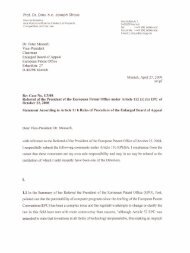Assessing the Obstacles to Industrialisation: The ... - Innovation
Assessing the Obstacles to Industrialisation: The ... - Innovation
Assessing the Obstacles to Industrialisation: The ... - Innovation
You also want an ePaper? Increase the reach of your titles
YUMPU automatically turns print PDFs into web optimized ePapers that Google loves.
loStephen H.Haberplant consisting of only 92 small fac<strong>to</strong>ries running just over 2j0,ooospindles was not large enough <strong>to</strong> support a textile-machinery industry.<strong>The</strong> Mexican market had not yet reached <strong>the</strong> minimum threshold size <strong>to</strong>support capital-goods producers. %'hen it did, later on in <strong>the</strong> century,changes in <strong>the</strong> size of scale economies in capital goods industries again put<strong>the</strong>m out of Mexico's reach, a subject we will return <strong>to</strong> in <strong>the</strong> next section.Reussessitzg <strong>the</strong> obstucles <strong>to</strong> growth, 1880-1910Beginning in <strong>the</strong> 1880s <strong>the</strong> obstacles which had earlier limited Mexicanindustrialisation began <strong>to</strong> be removed. <strong>The</strong> spark that set off this processwas <strong>the</strong> inflow of capital from <strong>the</strong> United States and Europe. During <strong>the</strong>last decades of <strong>the</strong> century foreign capital and foreign entrepreneurs (whopossessed knowledge about specific technologies and markets whichMexican capitalists did not) flowed in<strong>to</strong> <strong>the</strong> nation, draining andretimbering <strong>the</strong> mines, spurring <strong>the</strong> growth of commercial agriculture,developing <strong>the</strong> oil industry and financing <strong>the</strong> whirlwind construction ofa national railway system. By 1910, according <strong>to</strong> <strong>the</strong> available estimates,foreigners had invested close <strong>to</strong> $2 billion in Mexico's railroads, mines anda variety of o<strong>the</strong>r undertakings - a sum that accounted for between 67 and73 % of <strong>the</strong> <strong>to</strong>tal capital invested in <strong>the</strong> country." <strong>The</strong> greatest part of thisforeign investment was clustered in export-related enterprises.'<strong>The</strong> key area in<strong>to</strong> which foreign capital flowed was <strong>the</strong> transport sec<strong>to</strong>r.In I 873 Mexico possessed only 5 72 kilometres of railroads ;by I 88 3 it hadover j ,000. <strong>The</strong> network expanded <strong>to</strong> over 10,ooo kilometres by I 893 and<strong>to</strong> 16,000 in 1903 In 1910, just before <strong>the</strong> Revolution broke out, <strong>the</strong>Mexican rail system boasted over 19,000 kilometres of track. <strong>The</strong>se figuresaccount only for track laid under federal concession. In addition,commuter and feeder lines constructed under state or municipalconcessions accounted for an additional 7,8 10 kilometres.'"Although <strong>the</strong> system was laid out without any central plan, <strong>the</strong>government generally awarding concessions on an ad hoc basis, <strong>the</strong>ultimate effect was that a fairly well-integrated grid developed. <strong>The</strong>primary purpose of <strong>the</strong> railways was <strong>to</strong> move raw materials <strong>to</strong> <strong>the</strong> coas<strong>to</strong>r <strong>to</strong> <strong>the</strong> nor<strong>the</strong>rn border for export <strong>to</strong> foreign markets, but <strong>the</strong> sheernumber of feeder lines built eventually gave rise <strong>to</strong> an interconnected gridthat linked internal markets as well as <strong>the</strong> mining areas and <strong>the</strong> ports. By<strong>the</strong> turn of <strong>the</strong> century most of <strong>the</strong> major cities were connected <strong>to</strong> oneano<strong>the</strong>r by rail.With <strong>the</strong> arrival of <strong>the</strong> railroad, transport costs fell precipi<strong>to</strong>usly," Rodney Anderson, Oufcasfs in fhezr 0ii.n Land: Lllrszcan Industrial It;'orkers, 1906-1917(Ilekalb, Illinois, 1976), p. 19." Coatsworth, C;rou'th /[qainst Del~eiopmenf, pp. jh and 40.





